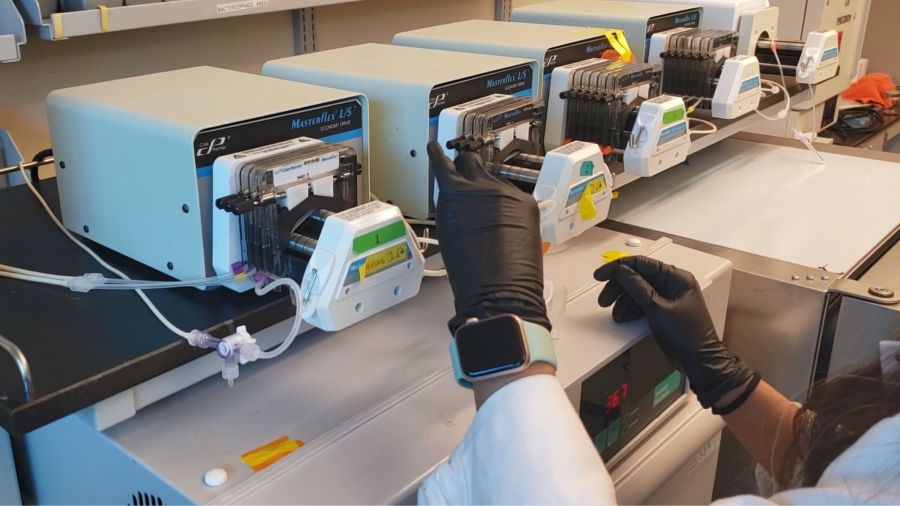HONOLULU (KHON2) — Genetics have been a big topic of mass discussion ever since the first Jurassic Park movie. But that was fiction. At Hawaiʻi’s John A. Burns School of Medicine, a research team is taking genetic coding to a whole new level.
First, let’s talk a bit about what the field of genetics is and why it’s important.
Genetics is the study of how traits are passed from parents to their children through genes. Genes are like tiny instructions inside our cells that tell our bodies how to grow and function.
Each person has thousands of genes, which are made up of DNA, a long molecule that looks like a twisted ladder. The order of the steps on this ladder, called bases, makes up our genetic code.
Genes determine many things about us, like our eye color, hair color and even some of our behaviors. Sometimes, people can have changes, or mutations, in their genes. These mutations can cause genetic disorders.
For example, if a gene that is supposed to help blood clot is mutated, a person might have hemophilia, a condition where their blood doesn’t clot properly.
Gene therapy is a technique where scientists try to fix these mutations by adding a healthy gene to replace the broken one.
Dr. Jesse Owens, who was born and raised in Hilo, is an assistant professor at the University of Hawaiʻi. He has been working on a new way to deliver genes into the human body to fix diseases. Current methods, like CRISPR, sometimes insert genes in random places, which can harm important genes and might cause cancer.
CRISPR also doesn’t work well in certain types of cells and has trouble with large pieces of DNA. Dr. Owens’s new technology can safely place large pieces of DNA into specific spots in all types of cells, whether they are dividing or not.
“The main thing that we’re trying to do is take a big piece of DNA and insert that into the human genome at a specific site,” explained Dr. Owens.
This is important because if the new gene lands in the wrong place, it could damage the cell or even cause cancer. By carefully placing the new gene, scientists hope to safely cure genetic disorders.
Dr. Owens has always been fascinated by the idea of gene therapy.
“I’ve always been fascinated with this concept of putting DNA into cells and into the genome,” explained Dr. Owens.
After studying at UC Santa Cruz and returning to Hawaiʻi for his PhD, he focused on putting genes into animals and creating glowing mice by using a gene that makes them glow.
Now, his work involves inserting large pieces of DNA into human cells to replace broken genes.
Gene therapy involves several steps.
First, scientists have to get the healthy gene into the body. This can be tricky because they need to get the gene into the right cells.
For some diseases, like blood disorders, this can be easier because the gene only needs to reach the bloodstream. For other diseases, like brain disorders, it’s more complicated.
Once the gene is inside the body, it needs to be inserted into the genome, the complete set of DNA in a cell. Dr. Owens and his team have developed a new method to make this process more efficient.
“We developed a new method for speeding that up where we can do a year’s worth of evolution in a single day,” said Dr. Owens. This means they can improve the proteins that help insert the DNA much faster than before.
You’ve probably heard of CRISPR technology during the heady days of COVID vaccination research during the pandemic.
CRISPR is a tool that scientists use to edit genes. It works like a pair of scissors that can cut DNA at a specific spot. After CRISPR makes a cut, the cell tries to repair the DNA. Sometimes, this repair process can be used to insert a new gene.
However, CRISPR has its limitations.
Dr. Owens explained, “CRISPR is really great… but it causes a DNA break and then lets the cell figure out a way to insert the DNA.”
This process isn’t always efficient, especially for inserting large genes. Dr. Owens’s method, on the other hand, uses an enzyme to actively insert the DNA into the genome, making it more reliable for adding large pieces of DNA.
One exciting application of gene therapy is in treating cancer. Dr. Owens describes a technique called CAR T-cell therapy. This involves taking T cells, a type of immune cell, from a patient’s blood and inserting a gene that helps these cells target and kill cancer.
“This is one of the best anti-cancer therapies out there,” said Dr. Owens.
Another potential use is for treating genetic disorders like hemophilia. By inserting a healthy gene into the blood, scientists can help the body produce the missing clotting factor. Dr. Owens’s team has achieved high efficiency in inserting these genes, which is crucial for the treatment to work.
“We’ve got the efficiencies up to 80%… which is the highest targeting efficiencies of this kind of genome editing that’s ever been described,” he added.
Dr. Owens hopes his research will lead to many new treatments. He wants to use his method to create CAR T-cell therapies for cancer and replace faulty genes in people with genetic disorders.
He’s even started a company to speed up the production of treatments, like antibodies, that can help fight diseases faster and cheaper.
You can click here for more information.
Gene therapy represents the cutting edge of genetic research. By improving how we insert genes into the genome, scientists like Dr. Owens are opening up new possibilities for treating diseases that were once thought incurable.
As Dr. Owens puts it, “This is kind of a big deal because what we’ve done is we’ve now reached a level of efficiency that it’s kind of unlocked a lot of applications.”
